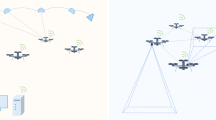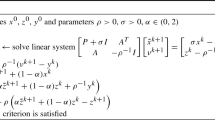Abstract
Numerical P systems (for short, NP systems) are distributed and parallel computing models inspired from the structure of living cells and economics. Enzymatic numerical P systems (for short, ENP systems) are a variant of NP systems, which have been successfully applied in designing and implementing controllers for mobile robots. Since ENP systems were proved to be Turing universal, there has been much work to simplify the universal systems, where the complexity parameters considered are the number of membranes, the degrees of polynomial production functions or the number of variables used in the systems. Yet the number of enzymatic variables, which is essential for ENP systems to reach universality, has not been investigated. Here we consider the problem of searching for the smallest number of enzymatic variables needed for universal ENP systems. We prove that for ENP systems as number acceptors working in the all-parallel or one-parallel mode, one enzymatic variable is sufficient to reach universality; while for the one-parallel ENP systems as number generators, two enzymatic variables are sufficient to reach universality. These results improve the best known results that the numbers of enzymatic variables are 13 and 52 for the all-parallel and one-parallel systems, respectively.
Similar content being viewed by others
References
Rozenberg G, Bäck T, Kok J N. Handbook of Natural Computing. Berlin: Springer, 2012
Miller W T, Werbos P J, Sutton R S. Neural Networks for Control. Cambridge: MIT Press, 1995
Păun G. Computing with membranes. J Comput Syst Sci, 2000, 61: 108–143
Păun G, Rozenberg G, Salomaa A. The Oxford Handbook of Membrane Computing. New York: Oxford University Press, 2010
Păun G. Membrane Computing: An Introduction. Berlin: Springer, 2012
Ciobanu G, Păun G, Pérez-Jiménez M J. Applications of Membrane Computing. Berlin: Springer, 2006
Frisco P, Gheorghe M, Pérez-Jiménez M J. Applications of Membrane Computing in Systems and Synthetic Biology. Berlin: Springer, 2014
Alhazov A, Sburlan D. Static sorting P systems. In: Applications of Membrane Computing. Berlin: Springer, 2006. 215–252
Nishida T Y. An approximate algorithm for NP-complete optimization problems exploiting P systems. In: Proceedings of the 1st Brainstorming Workshop on Uncertainty in Membrane Computing, Palma de Mallorca, 2004. 185–192
Nishida T Y. Membrane algorithms: approximate algorithms for NP-complete optimization problems. In: Applications of Membrane Computing. Berlin: Springer, 2006. 303–314
Enguix G B. Unstable P systems: applications to linguistics. Lect Notes Comput Sci, 2005, 3365: 190–209
Michel O, Jacquemard F. An analysis of a public key protocol with membranes. In: Applications of Membrane Computing. Berlin: Springer, 2006. 283–302
Dinneen M J, Kim Y B, Nicolescu R. P systems and the byzantine agreement. J Logic Algebr Program, 2010, 79: 334–349
Colomer M À, Montori A, García E, et al. Using a bioinspired model to determine the extinction risk of calotriton asper populations as a result of an increase in extreme rainfall in a scenario of climatic change. Ecol Model, 2014, 281: 1–14
Margalida A, Colomer M À. Modelling the effects of sanitary policies on european vulture conservation. Sci Rep, 2012, 2: 753
Ionescu M, Păun G, Yokomori T. Spiking neural P systems. Fund Inform, 2006, 71: 279–308
Peng H, Wang J, Pérez-Jiménez M J, et al. Fuzzy reasoning spiking neural P system for fault diagnosis. Inform Sci, 2013, 235: 106–116
Zeng X, Song T, Zhang X, et al. Performing four basic arithmetic operations with spiking neural P systems. IEEE Trans Nanobiosci, 2012, 11: 366–374
Zhang G, Cheng J, Wang T, et al. Membrane Computing: Theory & Applications (in Chinese). Beijing: Science Press, 2015
Zhang G, Rong H, Neri F, et al. An optimization spiking neural P system for approximately solving combinatorial optimization problems. Int J Neural Syst, 2014, 24: 1–16
Păun G, Păun R. Membrane computing and economics: numerical P systems. Fund Inform, 2006, 73: 213–227
Rivera D L, Naranjo M Á G. The pole balancing problem with enzymatic numerical P systems. In: Proceedings of the 13th Brainstorming Week on Membrane Computing, Sevilla, 2015. 195–206
Buiu C, Vasile C, Arsene O. Development of membrane controllers for mobile robots. Inform Sci, 2012, 187: 33–51
Wang X, Zhang G, Neri F, et al. Design and implementation of membrane controllers for trajectory tracking of nonholonomic wheeled mobile robots. Integr Comput Aid Eng, 2015, 23: 15–30
Arsene O, Buiu C, Popescu N. Snups—a simulator for numerical membrane computing. Int J Innov Comput Inform Control, 2011, 7: 3509–3522
Buiu C, Arsene O, Cipu C, et al. A software tool for modeling and simulation of numerical P systems. BioSystems, 2011, 103: 442–447
Pavel A B. Membrane controllers for cognitive robots. Dissertation for M.S. Degree. Bucharest: University of Bucharest, 2011
García-Quismondo M, Pavel A B, Pérez-Jiménez M d J, et al. Simulating large-scale ENPS models by means of GPU. In: Proceedings of the 10th Brainstorming Week on Membrane Computing, Sevilla, 2012. 137–152
Pavel A, Arsene O, Buiu C. Enzymatic numerical P systems—a new class of membrane computing systems. In: Proceedings of IEEE 5th International Conference on Bio-Inspired Computing: Theories and Applications (BIC-TA), Liverpool, 2010. 1331–1336
Leporati A, Mauri G, Porreca A E, et al, Enzymatic numerical P systems using elementary arithmetic operations. In: Proceedings of the 14th International Conference on Membrane Computing, Moldova, 2016. 249–264
Leporati A, Porreca A E, Zandron C, et al. Improved universality results for parallel enzymatic numerical P systems. Int J Unconv Comput, 2013, 9: 385–404
Vasile C I, Pavel A B, Dumitrache I. Universality of enzymatic numerical P systems. Int J Comput Math, 2013, 90: 869–879
Vasile C I, Pavel A B, Dumitrache I, et al. On the power of enzymatic numerical P systems. Acta Inform, 2012, 49: 395–412
Păun G. Some open problems about catalytic, numerical, and spiking neural P systems. In: Proceedings of Revised Selected Papers of the 14th International Conference on Membrane Computing, Chişinău, 2013. 33–39
Minsky M L. Computation: Finite and Infinite Machines. Englewood Cliffs: Prentice-Hall, 1967
Zhang Z, Pan L. Numerical P systems with thresholds. Int J Comput Commun Control, 2016, 11: 292–304
Zhang Z, Wu T, Păun A, et al. Numerical P systems with migrating variables. Theor Comput Sci, 2016, 641: 85–108
Acknowledgements
This work was supported by National Natural Science Foundation of China (Grant Nos. 61772214, 61320106005, 61033003, 61472154) and Innovation Scientists and Technicians Troop Construction Projects of Henan Province (Grant No. 154200510012). The work of Andrei P˘aun was supported by UEFSCDI Project RemoteForest Project (Grant No. PN-II-PTPCCA-2011-3.2-1710). This paper was written during a three-months stay of Zhiqiang Zhang and Tingfang Wu in Curtea de Arge¸s, Romania, in the fall of 2015.
Author information
Authors and Affiliations
Corresponding author
Rights and permissions
About this article
Cite this article
Zhang, Z., Wu, T., Păun, A. et al. Universal enzymatic numerical P systems with small number of enzymatic variables. Sci. China Inf. Sci. 61, 092103 (2018). https://doi.org/10.1007/s11432-017-9103-5
Received:
Accepted:
Published:
DOI: https://doi.org/10.1007/s11432-017-9103-5




